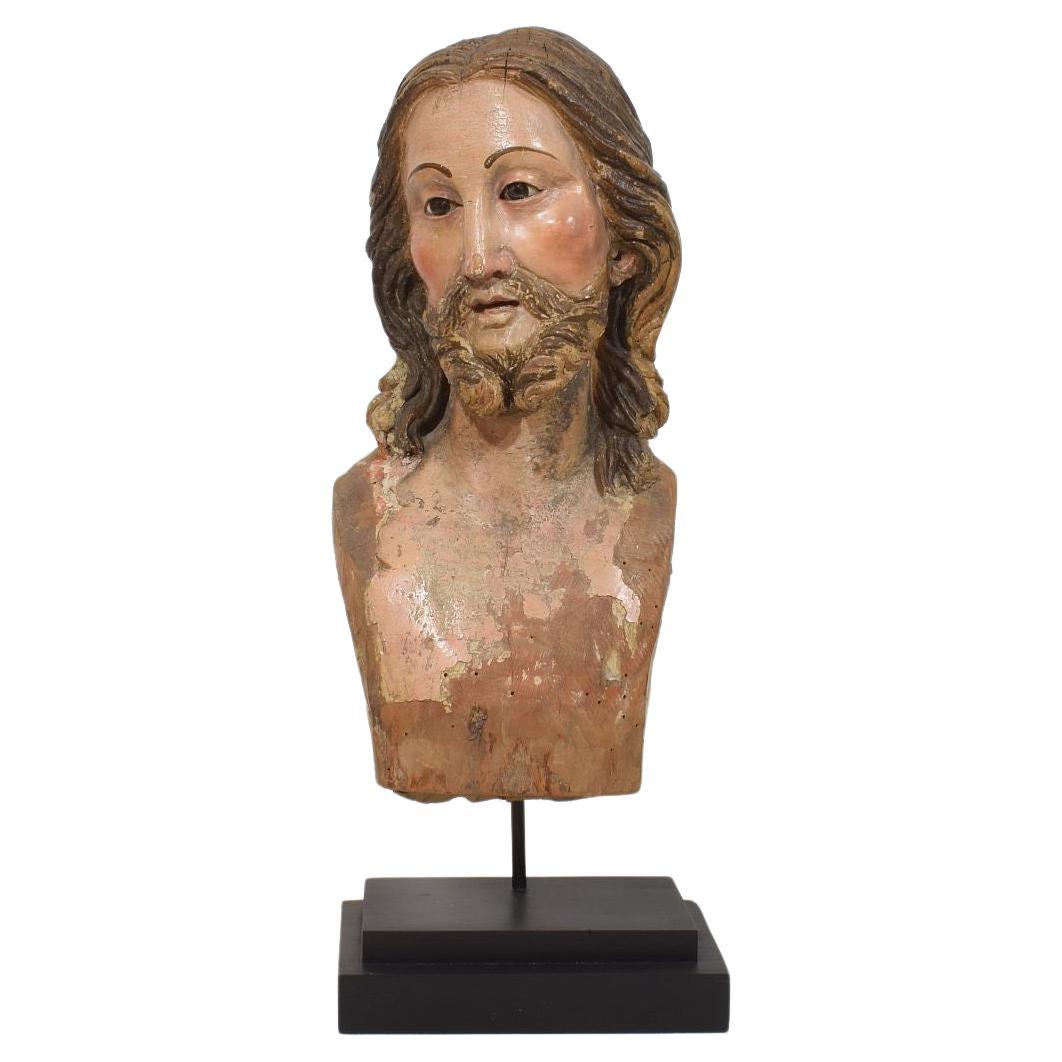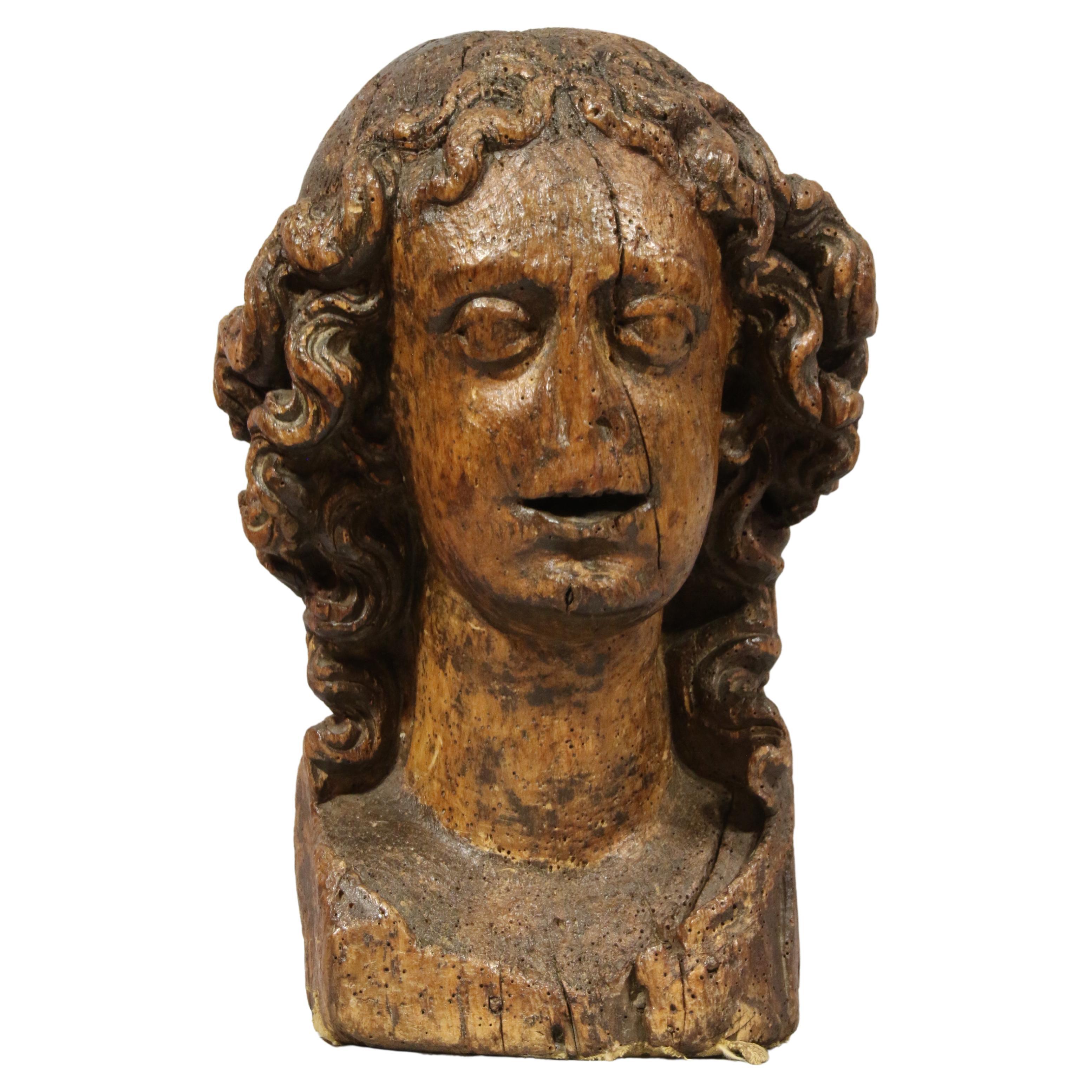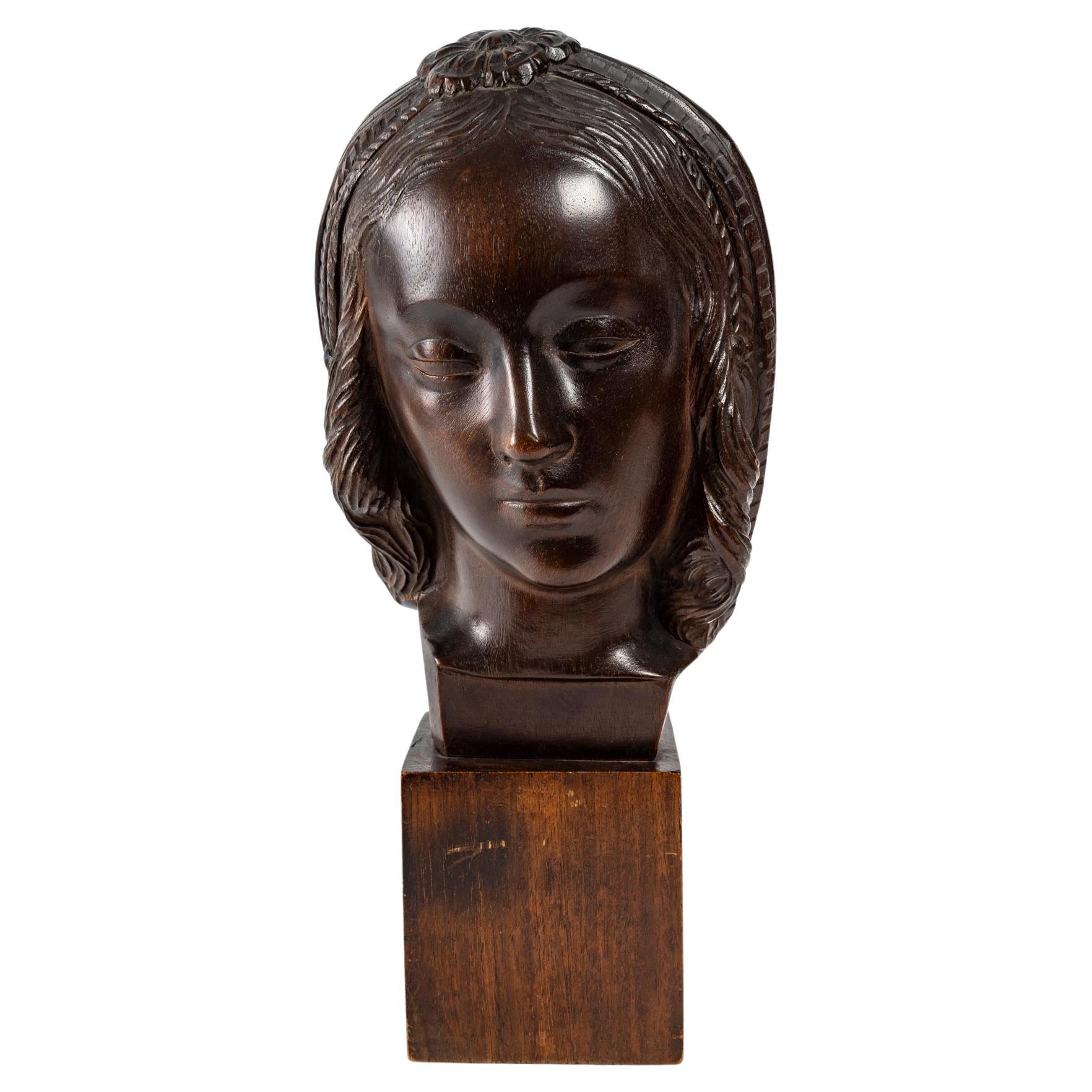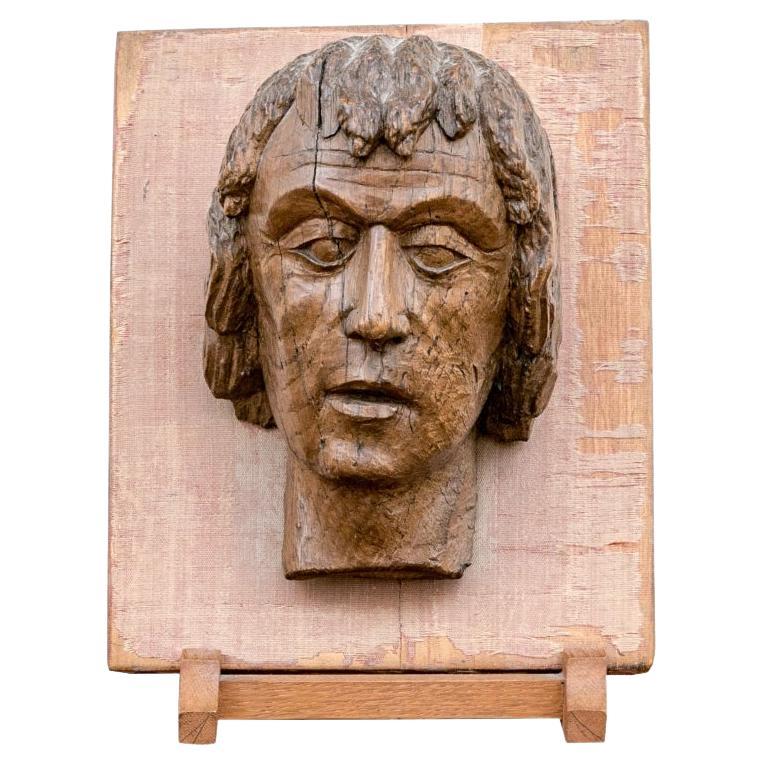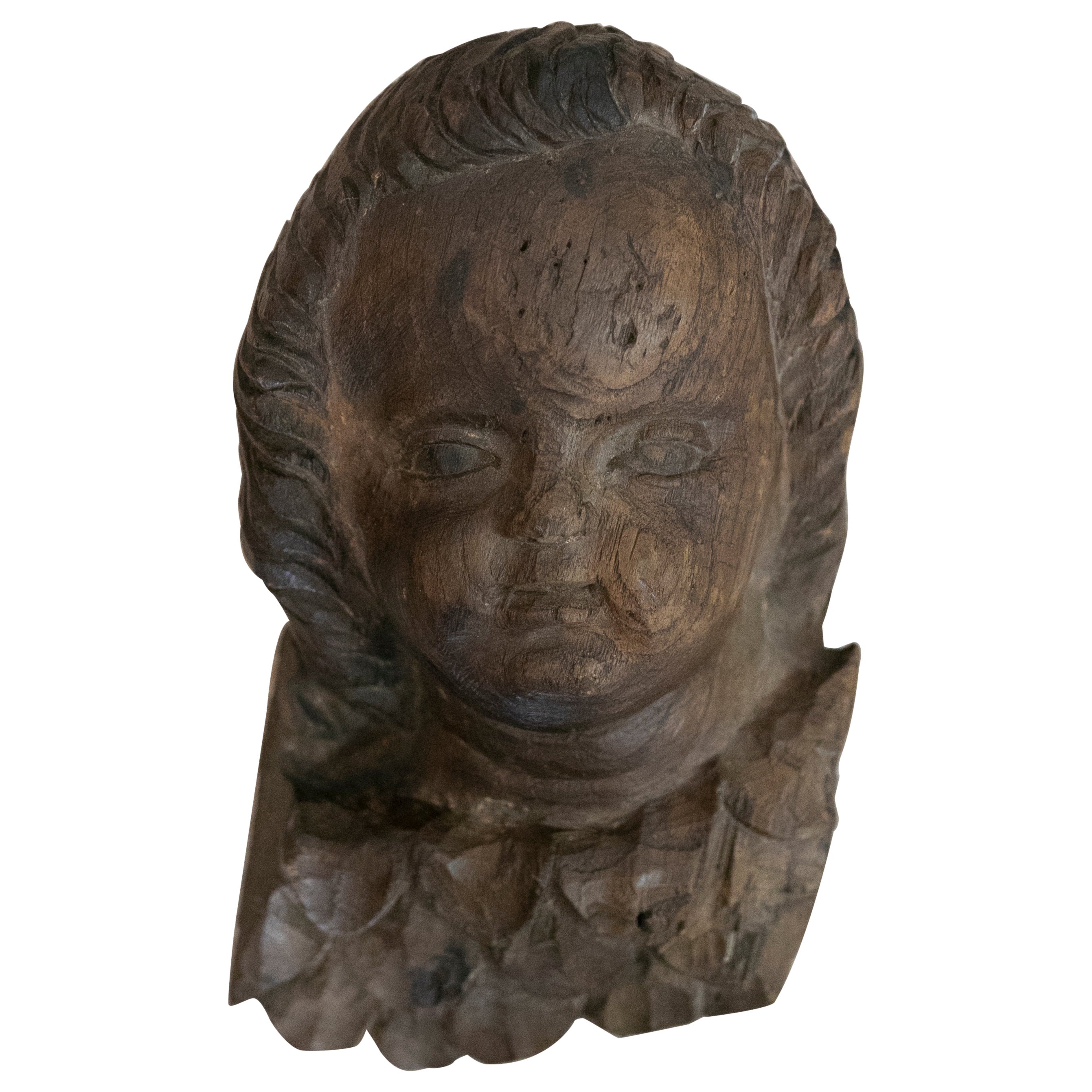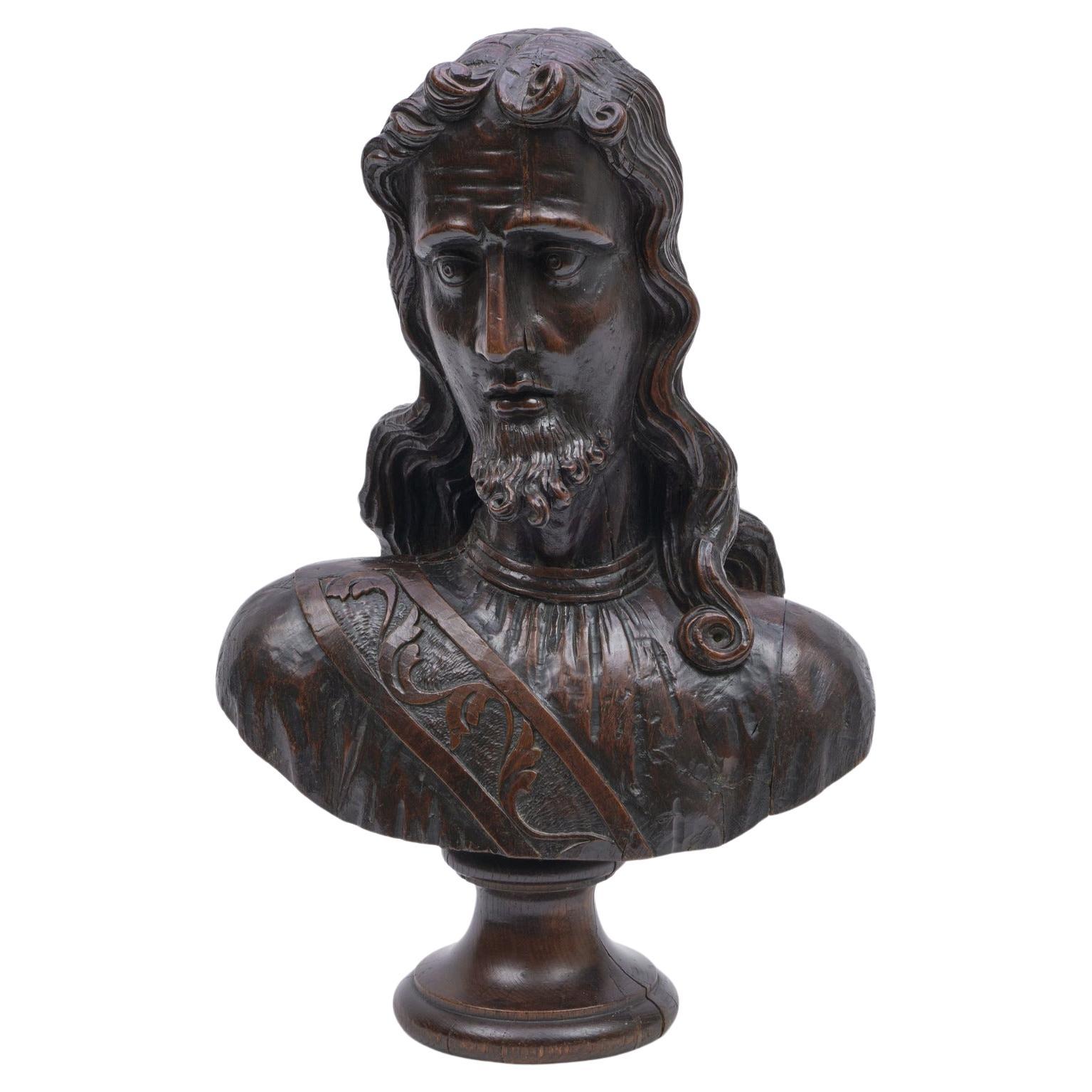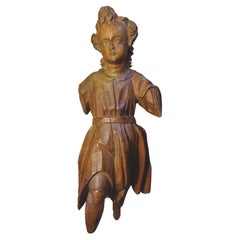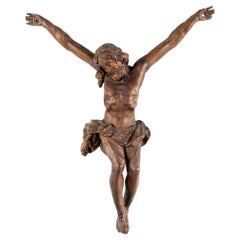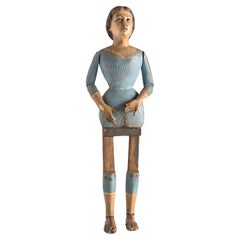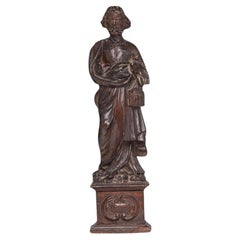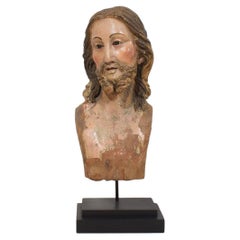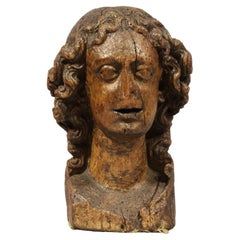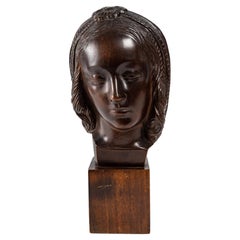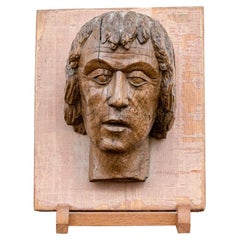Items Similar to 15th century Florentine Sculpted Wooden Head of Christ
Want more images or videos?
Request additional images or videos from the seller
1 of 8
15th century Florentine Sculpted Wooden Head of Christ
$7,995
£6,042.67
€6,964.42
CA$11,280.95
A$12,432.39
CHF 6,508.77
MX$152,709.02
NOK 81,784.09
SEK 76,543.40
DKK 51,999.19
About the Item
Head of Christ, fragment of a Lamentation group
Possibly Maiano Workshop - Giovanni da Maiano (d. 1478) (?)
Florence, Italy; probably late 1460s or early 1470s
Presumably limewood; approximate size: 16 x 24 x 6 cm
This pleasantly conceived sculpture gracefully captures the effigy of Christ expired with its serene soulfulness that is both striking and convincing. The spiraling locks of hair framing Christ’s lower face are in eloquent balance with the terminating curls of his beard and the overall management of the sculptor’s hand implies a talented maker.
The present head of Christ is distinctively Florentine in essence, datable to the last third of the 15th century. Devotional art in Florence was in significant demand during the Quattrocento, destined for use in private chapels, oratories and convents in Florence and outlying areas. In the latter part of the century, Florence boasted more wood-carvers than butchers, being a testament to the value placed upon the desire for sacred art in that city. A majority of commissions were realized by Florentine artists like those belonging to the Maiano and Sangallo dynasty of sculptors as well as individual sculptors and their studios like Leonardo del Tasso, Baccio da Montelupo, Antonfrancesco Bugiardini, Baccio d’Agnolo, Francesco Rustici, Andrea Sansovino, the Master of the Scapigliati Crucifixes, et al.
Specifically, our sculpture represents a fragment for what would have formed the full figure of Christ belonging to a compianto or Lamentation group of free-standing sculptures executed in wood, modeled further in stucco and painted in vibrant color. The figure of Christ would have been shown reclined, laid supine on the floor or stage and surrounded by mourners. Other such groups, were executed in-and-around Florence like those observed realized in terracotta by Michele da Firenze (Galleria Estense)one attributed to Leonardo del Tasso, ca. 1490 (Berlin Museums), or another in the ambit of Baccio da Montelupo, ca. 1515-20 (Museo d’Arte Sacra di San Francesco di Greve in Chianti).
In particular, our head of Christ aligns with the milieu of works produced by the Maiano brothers whose workshop the elder brother Giuliano owned and established along Via de’ Servi during the 1450s. Alongside Giuliano were his two younger brothers, Giovanni and Benedetto, the latter of whom became a much-respected and distinguished sculptor during the last part of the 15th century.
The distinctive tubular corkscrew curls present on the hair and beard of our Christ are superficially analogous with those belonging to a crucifix ascribed to Giuliano da Maiano or his ambit at the Cardini Chapel in the Church of San Francesco in Pescia while the overall disposition of Christ’s face is reflective of crucifixes by Benedetto da Maiano like the documented example executed toward the end of his career at the cathedral of Santa Maria del Fiore and especially the crucifix kept at the oratory of Santa Maria della Misericordia in Florence, adjudged ca. 1478, which originally belonged to Benedetto’s estate upon his death (Fig. 01). Although this crucifix is heavily overpainted, the general form of its underlying sculpted character is commensurate with our present head of Christ, especially when observed in-profile.
By technical standards our present head of Christ is further reflective of the working methods observed in the construction of crucifixes realized by Benedetto da Maiano, presumably inherited from the practices employed by his brothers. The head is carved from a solid trunk and the neck extends for fitting into a hollowed-out upper body with further parts to-be-attached along the right-and-left sides of the sculpture. The application of painted stucco atop the wood sculpture is likewise commensurate and the trace attachment of stucco-modeled hair running down Christ’s back, is applied in the same manner as observed on the Misericordia crucifix.
A further homogeny between our head of Christ and the work of the Maiano brothers is observed in the sculptural language of a marble altar frontal depicting a Pietá in relief in the oratory of the Madonna dell’Olivo at Prato Cathedral. Although the frontal has been traditionally assigned to the overall Maiano workshop, Francesco Caglioti has attributed the relief specifically to the brother, Giovanni da Maiano, ca. 1477-78, being an advanced work prior to his premature death in 1478 (Fig. 02). While Giovanni’s oeuvre remains largely undeciphered Caglioti likewise attributes a marble Madonna with the Child and St. John at Monte dei Paschi in Siena to his involvement. As the Maiano workshop was prolific in the production of works-in-wood, our present head of Christ may indicate an earlier work by Giovanni, if by his hand, perhaps executed during the late 1460s or early 1470s. If correct, it is to be wondered if the Misericordia crucifix, forming part of Benedetto’s estate, may not be Benedetto’s workmanship but rather that of his brother, or possibly a collaborative work between both brothers, perhaps kept by Benedetto as a keepsake after Giovanni’s death in 1478. The similarities between our head of Christ and the Misericordia crucifix are potentially suggestive of this idea.
The head of Christ, with its consonance of style reflective of both the elder Giuliano and younger Benedetto and its relevance to the Pietá frontal ascribed to Giovanni, may situate this fragment as a possible rare survival of Giovanni da Maiano’s workmanship. Apart from the inherent influence of his brothers, the head of Christ may also draw reference from Domenico Ghirlandaio’s frescoed depiction of Christ in his Lamentation scene for the Vespucci Chapel at the chiesa di Ognissanti in Florence, completed in 1472, perhaps intimating a more precise dating for our sculpture.
While no documentary evidence has come forth concerning the execution of a compianto in wood by the Maiano workshop, Giancarlo Gentilini and Caglioti have brought attention to a terracotta compianto group executed by Benedetto ca. 1485-88 for the chapel of Girolamo Talducci at Santa Trinita a Prato whose fragments survive in various collections.
In consideration of the aforenoted, it is to be further speculated if the painter, Neri di Bicci and his workshop could have been responsible for painting the present head of Christ as the Maiano workshop regularly collaborated with di Bicci from 1455-72 for the painting of tables, altarpieces, frames, candelabra, crucifixes, chests, reliquaries and other objects-of-devotion. Other Florentines turned to Bicci for the painting of sculpture, including Desiderio da Settignano and Don Romualdo da Candeli. However, other local painters should not be ruled out as candidates in the painting of our bust, such as Alesso Baldovinetti, with whom the Maiano also occasionally collaborated. The trace feature of blood from Christ’s crown-of-thorns is superficially comparable with Benedetto’s relief of the Veil of Veronica at the convent of Santa Maria del Carmine in Florence.
Condition: Worming with traces of original polychrome and stucco.
Provenance: a noble Italian family.
- Dimensions:Height: 9.5 in (24.13 cm)Width: 6.3 in (16.01 cm)Depth: 5 in (12.7 cm)
- Style:Renaissance (Of the Period)
- Materials and Techniques:
- Place of Origin:
- Period:
- Date of Manufacture:unknown
- Condition:Wear consistent with age and use.
- Seller Location:Leesburg, VA
- Reference Number:1stDibs: LU8166242337712
About the Seller
4.7
Vetted Professional Seller
Every seller passes strict standards for authenticity and reliability
Established in 2013
1stDibs seller since 2023
44 sales on 1stDibs
Typical response time: 1 hour
- ShippingRetrieving quote...Shipping from: Bruxelles, Belgium
- Return Policy
Authenticity Guarantee
In the unlikely event there’s an issue with an item’s authenticity, contact us within 1 year for a full refund. DetailsMoney-Back Guarantee
If your item is not as described, is damaged in transit, or does not arrive, contact us within 7 days for a full refund. Details24-Hour Cancellation
You have a 24-hour grace period in which to reconsider your purchase, with no questions asked.Vetted Professional Sellers
Our world-class sellers must adhere to strict standards for service and quality, maintaining the integrity of our listings.Price-Match Guarantee
If you find that a seller listed the same item for a lower price elsewhere, we’ll match it.Trusted Global Delivery
Our best-in-class carrier network provides specialized shipping options worldwide, including custom delivery.More From This Seller
View AllBaroque Period Bohemian Wooden Angel Sculpture Fragment
Located in Leesburg, VA
Rococo Period Bohemian Wooden Angel Sculpture Fragment
Anonymous
Bohemia; ca. 1700
Oak
Approximate size: 17 (h) x 7 (w) x 4.75 (d) in.
The present oakwood sculpture, with its cinc...
Category
Antique Early 1700s Czech Rococo Wall-mounted Sculptures
Materials
Oak
A Rustic Wooden 17th century Baroque Flemish Corpus of Christ
Located in Leesburg, VA
Anonymous
Belgium; ca. 1650-1700
Wood (walnut?)
Approximate size: 22.75 (h) x 18.5 (w) x 10 (d) in.
The scale of this sculpture indicates its original setting was either in the cen...
Category
Antique Late 17th Century Belgian Baroque Wall-mounted Sculptures
Materials
Walnut
19th Century Articulated Wooden Figure of the Virgin Mary
Located in Leesburg, VA
19th century articulated wooden figure of the Virgin Mary
Anonymous
Spain; 19th century
Polychrome wood, inset glass eyes
Approximate size: 37 x 11 x 7 cm
An antique ‘Virgin...
Category
Antique 19th Century Primitive Figurative Sculptures
Materials
Glass, Wood, Paint
$1,496 Sale Price
52% Off
An antique 18th century Walnut European Santos - Saint figure on a plinth
Located in Leesburg, VA
An antique 18th century Walnut Figural Statue of Saint Peter on a plinth
Anonymous
Northern Europe, probably Belgium; first-half of the 18th century
Walnut
Approximate size: 17 (h) x 4.25 (w) x 4.25 (d) in.
The present sculpture, perfectly suited for a curiosity cabinet or English-European country styled home, was likely realized for a church side chapel or choir stall niche. The serious look of the saint’s face...
Category
Antique Early 18th Century Belgian Baroque Figurative Sculptures
Materials
Walnut
Rare and important painted bronze Crucifix after a model by Michelangelo
By Michelangelo Buonarroti
Located in Leesburg, VA
A rare and very fine bronze corpus of Christ after a model by Michelangelo, cast ca. 1597-1600 by Juan Bautista Franconio and painted in 1600 by Francisco Pacheco in Seville, Spain.
The present corpus reproduces a model attributed to Michelangelo. The best known example, lesser in quality, is one on display at the Metropolitan Museum of Art (MET).
The association of this corpus with Michelangelo was first brought to light by Manuel Gomez-Moreno (1930-33) who studied the wider circulated casts identified throughout Spain. The attribution to Michelangelo was subsequently followed by John Goldsmith-Phillips (1937) of the MET and again by Michelangelo expert, Charles de Tolnay (1960).
While Michelangelo is best known for his monumental works, there are four documented crucifixes he made. The best known example is the large-scale wooden crucifix for the Church of Santa Maria del Santo Spirito in Florence, made in 1492 as a gift for the Prior, Giovanni di Lap Bicchiellini, for allowing him to study the anatomy of corpses at the hospital there. In 1562, Michelangelo wrote two letters to his nephew, Lionardo, indicating his intention to carve a wooden crucifix for him. In 1563 a letter between Lionardo and the Italian sculptor Tiberio Calcagni, mentions this same crucifix (a sketch of a corpus on the verso of a sheet depicting Michelangelo’s designs for St. Peter’s Basillica [Palais des Beaux-Arts in Lille] may reproduce this). That Michelangelo was working on small corpora in the last years of his life is further evidenced by the small (26.5 cm) unfinished wooden crucifix located at the Casa Buonarroti, considered his last known sculptural undertaking. Michelangelo’s contemporary biographer, Giorgio Vasari additionally cites that Michelangelo, in his later years, made a small crucifix for his friend, Menighella, as a gift.
Surviving sketches also indicate Michelangelo’s study of this subject throughout his career, most notably during the end of his life but also during the 1530s-40s as he deepened his spiritual roots. The occasional cameo of crucified Christ’s throughout his sketched oeuvre have made it challenging for scholars to link such sketches to any documented commissions of importance. All the while, in consideration that such objects were made as gifts, it is unlikely they should be linked with commissions.
Nonetheless, a number of theories concerning Michelangelo’s sketches of Christ crucified have been proposed and some may regard the origin of the present sculpture. It has been suggested that the corpus could have its impetus with Michelangelo’s work on the Medici Chapel, whose exclusive design was given to the master. It is sensible smaller details, like an altar cross, could have fallen under his responsibility (see for example British Museum, Inv. 1859,0625.552). Others have noted the possibility of an unrealized large marble Crucifixion group which never came to fruition but whose marble blocks had been measured according to a sheet at the Casa Buonarroti.
A unique suggestion is that Michelangelo could have made the crucifix for Vittoria Colonna, of whom he was exceedingly fond and with whom he exchanged gifts along with mutual spiritual proclivities. In particular, Vittoria had an interest in the life of St. Bridget, whose vision of Christ closely resembles our sculpture, most notably with Christ’s proper-left leg and foot crossed over his right, an iconography that is incredibly scarce for crucifixes. The suggestion could add sense to Benedetto Varchi’s comment that Michelangelo made a sculpted “nude Christ…he gave to the most divine Marchesa of Pescara (Vittoria Colonna).”
Of that same period, two sketches can be visually linked to our sculpture. Tolnay relates it to a sketch of a Crucified Christ at the Teylers Museum (Inv. A034) of which Paul Joannides comments on its quality as suggestive of preparations for a sculptural work. Joannides also calls attention to a related drawing attributed to Raffaello da Montelupo copying what is believed to be a lost sketch by Michelangelo. Its relationship with our sculpture is apparent. Montelupo, a pupil of Michelangelo’s, returned to Rome to serve him in 1541, assisting with the continued work on the tomb of Pope Julius II, suggesting again an origin for the corpus ca. 1540.
The earliest firm date that can be given to the present corpus is 1574 where it appears as a rather crudely conceived Crucifixion panel, flanked by two mourners in low-relief and integrally cast for use as the bronze tabernacle door to a ciborium now located at the Church of San Lorenzo in Padula. Etched in wax residue on the back of the door is the date, 27 January 1574, indicating the corpus would have at least been available as a model by late 1573.
The Padula tabernacle was completed by Michelangelo’s assistant, Jacopo del Duca and likely has its origins with Michelangelo’s uncompleted tabernacle for the Basilica of St. Mary of the Angels in Rome.
The impetus for the Padula tabernacle’s Crucifixion panel begins with a series of late Crucifixion sketches by Michelangelo, depicting a scene of Christ crucified and flanked by two mourners (see British Museum Inv. 1895.0915.510; Ashmolean Museum Inv. 1846.89, KP II 343 recto; Windsor Castle RCIN 912761 recto; and Louvre Inv. 700). A faintly traced block possibly intended for sculpting the sketch of the crucified Christ on its recto was discovered by Tolnay on a version of the composition at Windsor Castle. The Windsor sketch and those related to it appear to have served as preparatory designs for what was probably intended to become the Basilica of St. Mary’s tabernacle door. Vasari documents that the project was to be designed by Michelangelo and cast by his assistant, Jacopo del Duca. Michelangelo died before the commission was complete, though on 15 March 1565, Jacopo writes to Michelangelo’s nephew stating, “I have started making the bronze tabernacle, depending on the model of his that was in Rome, already almost half complete.” Various circumstances interrupted the completion of the tabernacle, though its concept is later revitalized by Jacopo during preparations to sell a tabernacle, after Michelangelo’s designs, to Spain for Madrid’s El Escorial almost a decade later. The El Escorial tabernacle likewise encountered problems and was aborted but Jacopo successfully sold it shortly thereafter to the Carthusians of Padula.
An etched date, 30 May 1572, along the base of the Padula tabernacle indicates its framework was already cast by then. A 1573 summary of the tabernacle also describes the original format for the door and relief panels, intended to be square in dimension. However, a last minute decision to heighten them was abruptly made during Jacopo’s negotiations to sell the tabernacle to King Phillip II of Spain. Shortly thereafter the commission was aborted. Philippe Malgouyres notes that the Padula tabernacle’s final state is a mixed product of the original design intended for Spain’s El Escorial, recycling various parts that had already been cast and adding new quickly finished elements for its sale to Padula, explaining its unusually discordant quality, particularly as concerns the crudeness of the door and relief panels which were clearly made later (by January 1574).
Apart from his own admission in letters to Spain, it is apparent, however, that Jacopo relied upon his deceased master’s designs while hastily realizing the Padula panels. If Michelangelo had already earlier conceived a crucifix model, and Jacopo had access to that model, its logical he could have hastily employed it for incorporation on the door panel to the tabernacle. It is worth noting some modifications he made to the model, extending Christ’s arms further up in order to fit them into the scale of the panel and further lowering his chin to his chest in order to instill physiognomic congruence. A crude panel of the Deposition also follows after Michelangelo’s late sketches and is likewise known by examples thought to be modifications by Jacopo based upon Michelangelo’s initial sculptural conception (see Malgouyres: La Deposition du Christ de Jacopo del Duca, chef-d’oeuvre posthume de Michel-Ange).
Jacopo’s appropriation of an original model by Michelangelo for more than one relief on the Padula tabernacle adds further indication that the crucifix was not an object unique to Jacopo’s hand, as few scholars have posited, but rather belongs to Michelangelo’s original...
Category
Antique 16th Century Renaissance Figurative Sculptures
Materials
Bronze
18th century Neapolitan Terracotta Santo Presepio Figure of Saint Anna
Located in Leesburg, VA
18th century Neapolitan Terracotta Santo Presepio Figure of Saint Anna
Anonymous
Naples, Italy; ca. 1760
Polychrome terracotta, wood, silk, gla...
Category
Antique 1760s Italian Baroque Figurative Sculptures
Materials
Terracotta, Silk, Glass, Wood
You May Also Like
Large 18th Century Italian / Neapolitan Hand Carved Wooden Head of Christ
Located in Buisson, FR
Unique handcarved wooden head of Christ with beautiful expression and glass eyes, once used at processions.
Napels/ Italy, circa 1750-1800. Beautiful example of 18th century craftsma...
Category
Antique 18th Century Italian Baroque Religious Items
Materials
Gesso, Glass, Wood
$3,045 Sale Price
28% Off
14th Century Sculpture of the Head of an Angel from East of France or Rhineland
Located in Saint-Ouen, FR
This face with prominent eyes, open mouth and beautiful hairs with symetrical undulations may be the face of the Archangel Gabriel.
Category
Antique 15th Century and Earlier French Gothic Figurative Sculptures
Materials
Wood
Head of a Woman, Wood Sculpture, Art Deco, 1930
Located in Saint-Ouen, FR
Head of a woman, wood sculpture, Art Deco, 1930
Carved wood sculpture, in the taste of the renaissance, beautiful quality of work, 1930, Art Deco style.
H: 36 cm, W: 18 cm, D: 17 c...
Category
Vintage 1930s European Renaissance Figurative Sculptures
Materials
Wood
Antique Carved Wood Head Of A Male Mounted On Panel
Located in Bridgeport, CT
A well carved hardwood bust reminiscent of sacred and religious sculpture of the Gothic and Renaissance eras. Antique carved wood head of a mal...
Category
Antique 19th Century Renaissance Busts
Materials
Hardwood
18th Century Angel's Head Sculpture Handcarved in Wood
Located in Marbella, ES
18th century Angel's head sculpture handcarved in wood.
Category
Antique Mid-18th Century Spanish Busts
Materials
Wood
A Monumental 16th Century Renaissance Carved Oak Bust of Jesus Christ
Located in Queens, NY
Magnificent and Monumental 16th Century Renaissance Carved Oak Bust of Christ, Flemish Netherlandish, C. 1550
A powerful and deeply expressive Renaissance carved oak bust of Jesus C...
Category
Antique 16th Century Dutch Renaissance Busts
Materials
Oak
More Ways To Browse
Italian Wood Carving
15th Century Italian
Head Of Christ
Hand Carved Christ
Italian Renaissance 15th Century
Hand Carved Santas
Antique Wood Christ
Leonardo Collection
Italian Polychrome Wood Table
Christ Carved
Marble Altar
Crown Of Thorns
Antique Corkscrews
Italian Crucifix
Hand Reliquary
Hand Carved Wood Crucifix
15th Century Wood Carving
Wooden Christ
